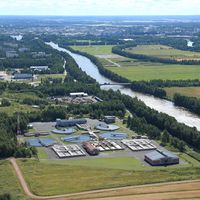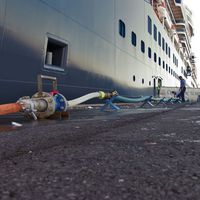Information
Information
Weighing up an investment is about comparing its costs and benefits; this should be remembered in the case of water protection measures. If decision-making is focused solely on the costs, the various benefits that water protection can provide both locally and at Baltic Sea level will be ignored. These benefits – which may outweigh the costs – cannot be gained without water protection investments.
Thus, in order to make wise decisions, decision-makers should be aware of the overall and long-term impacts of investments. Such information is required when deciding whether or not to implement a project, or which one to choose from the alternatives.
Cost-benefit analysis as a decision-making tool
A cost-benefit analysis (CBA) is a tool for evaluating the overall benefits and costs of investments. For example, it enables comparisons between current costs and future environmental benefits. As a result, it provides information on how worthwhile the considered investment would be for society in the long run.
A cost-benefit analysis also takes account of non-monetary impacts, e.g. environmental benefits. This is achieved by using financial methods to turn such impacts into monetary values. Monetary values are usually based on the willingness to pay for a better environment.
Lessons learned from cost-benefit analysis case studies of the CITYWATER project
A cost-benefit analysis of five water protection measures implemented by municipalities around the Baltic Sea was conducted as part of the EU Life+ co-funded project CITYWATER. One of the study’s key findings was that every local water protection measure had been worthwhile and represented a crucial step towards getting local waters and the Baltic Sea into good condition.
The studied case measures are introduced in Examples. In Instructions & Recommendations you will find support in how to identify the need for and perform a cost-benefit analysis (CBA). Further information on the CITYWATER study, as well as the CBA method in general, can be found in Extras.
Examples
Examples
In the map below, you will find examples of water protection measures related to this topic. These actions were selected from the Bank of Actions – if you are interested in browsing other water protection actions, visit the Bank of Actions.
![]() Agriculture
Agriculture
![]() Awareness raising
Awareness raising
![]() Hazardous materials
Hazardous materials
![]() Littering etc.
Littering etc.
![]() Oil spill prevention
Oil spill prevention
![]() Research and monitoring
Research and monitoring
![]() Shipping and boating
Shipping and boating
![]() Stormwater management
Stormwater management
![]() Strategies and programs
Strategies and programs
![]() Wastewater management
Wastewater management
![]() Other
Other
![]() Drainage basin
Drainage basin
Contributed professorship
Actor: City of Helsinki and University of Helsinki ● Year: 2011 ● Address: Viikinkaari 11, Helsinki, Finlanf
The City of Helsinki contributed to a new professorship of the Economics of Baltic Sea Protection to the University of Helsinki in 2011. Professor Kari Hyytiäinen started in the office in October 2013. Before him the professorship was held by Jussi Lankoski (2011-2013).
Description
The professorship in the economics of Baltic Sea protection has been extended until 2021. The new five-year period is financed jointly by the City of Helsinki and the University of Helsinki. In the co-operation stemming from the Baltic Sea Challenge initiative the research questions arise from practical water protection questions. On the other hand the professorship enables more general scientific research results to be applied on local water protection. Already the first five-year period has produced a lot of economic research on the Baltic Sea issues e.g. for supporting the decision making in the city of Helsinki. The extension enables the continuity of the research and secures a new expert generation to be trained. The costs of the professorship to the City of Helsinki are €100,000 per year. The University of Helsinki's share is €15,000 per year.
During the last three years of his term, professor Kari Hyytiäinen has published 13 peer-reviewed scientific articles, 5 other research publications, given several interviews and written popular articles. Hyytiäinen is also in charge of a Baltic wide research project (BONUS BalticAPP), in which the demand and supply of ecosystem services provided by the Baltic Sea are examined in scenarios during the next century. During the next years the research focuses on mapping the challenges the changing climate and global socioeconomic trends will bring about in the protection of the Baltic Sea.
Benefits
Professor Hyytiäinen wants to bring up information that can be used to support decision-making in the society when considering the saving of the Baltic Sea, and costs of these measures - both in Finland and internationally. The aim is to have a healthy sea, sustainable use of it and the possibility to leave the Baltic Sea for the generations to come as a resource of welfare.
Especially eutrophication, invasive species and risks of oil spill are of interest to professor Hyytiäinen. Also there are new, less well known threats like microplastics. The effects of climate change have to be taken into account when planning measures to improve the state of the sea. Locally Hyytiäinen's research is conducted in the Vantaanjoki river drainage area and the coastal waters off Helsinki.
Background information
The professorship in the Economics of Baltic Sea Protection has a central role in the Baltic Sea co-operation program of the University of Helsinki and City of Helsinki, and is included in the joint Baltic Sea Action Plan of the cities of Helsinki and Turku.
Further information
Name: Kari Hyytiäinen ● Email: kari.hyytiainen (a) helsinki.fi ● Web page: http://www.helsinki.fi/yliopisto/
Guidelines & Recommendations
Guidelines & Recommendations
How do I know whether a cost-benefit analysis is needed?
A cost-benefit analysis (CBA) is a useful tool, recommended when gathering information in support of decision-making. How do we identify the need for a CBA?
The following cost-benefit approach will help you to learn more about the case under planning and to discern whether CBA or other methods are needed. It will also help you to understand what needs to be taken into account when assessing the overall impacts of water protection actions. These recommendations were drawn up as part of the EU Life+ project CITYWATER.
[xa_acc style=”xa-default”][xa_slide title=”Specify the considered measure(s).” icon=”plus”]Specify the measure(s) being considered. Also specify alternative measures, including the status quo whereby the current situation persists and no measures are implemented.
[/xa_slide][xa_slide title=”Identify the potential impacts of the measure and list them.” icon=”plus”]Begin by considering the positive and negative impacts related to similar measures, or to measures grouped under the same water protection theme. Then consider which of them are potential candidates for selection as the measure in question. Also consider the likely impacts if the measure is not implemented. Categorise the potential impacts into positive and negative ones and those which may fall into either category.
[/xa_slide][xa_slide title=”Place the impacts and mark the current year on a time line.” icon=”plus”]Which impacts will occur within a certain period and which may be continuous or last for a certain period? Which impacts may occur in the near future and which only after a few years?
[/xa_slide][xa_slide title=”Consider the magnitude and relevance of the impacts.” icon=”plus”]Consider who will be affected by the measure’s implementation. Which of the impacts will be global, regional or local? Will they be long or short in duration? Could the impacts have a direct or indirect effect on social welfare? How extensive are the groups they will affect? Consider the issue at the level of citizens, how significant will the impacts be at this level? Also give thought to the difficulty of providing answers to such questions – this may reveal the level of uncertainty related to the impacts.
[/xa_slide][xa_slide title=”Consider the overall impacts.” icon=”plus”]Which of the potential impacts seem to be the most significant? Are they clearly positive or negative? Is there a higher number of positive or negative impacts? Would some impacts have the potential to provide additional benefits or cost savings? How about impacts posing a risk of either additional costs or loss of benefits? If there are any such impacts, how significant might they be?
[/xa_slide][xa_slide title=”Consider whether some of the impacts should be assessed more in detail.” icon=”plus”] If so, which impacts should be assessed in this way? By what indicators should they be measured? Which impacts may be crucial from the decision-making perspective? What kind of additional information is required in order to facilitate decision-making?
[/xa_slide][xa_slide title=”Consider if the overall impacts should be assessed in support of decision-making.” icon=”plus”] Is a comparison between the different impacts or measures in question difficult? If you are considering resource allocation between water protection and other sectors (e.g. traffic), would such assessments support the prioritisation of water protection measures?
[/xa_slide][xa_slide title=”If decision-making requires a comparison of overall impacts, perform a cost-benefit analysis.” icon=”plus”] Also consider other methods, e.g. a qualitative cost-benefit analysis or cost-effectiveness analysis, which may be less challenging but provide additional information for decision-making purposes (read more below).[/xa_slide][/xa_acc]
The various alternatives to a cost-benefit analysis – which should you choose?
Performing a cost-benefit analysis and, in particular, monetising the full range of impacts may require more than the available time, data, expertise and other resources. Alternative methods may therefore be useful. The following is based on Boardman et al 2014 (see Extras).
Qualitative cost-benefit analysis
This is an alternative to a conventional cost-benefit analysis. It involves a partial cost-benefit analysis, monetising as many of the project’s impacts as possible. The other impacts are quantified using other numerical values. If the impacts cannot be evaluated in quantitative terms, their relative importance should be estimated in qualitative terms.
A qualitative CBA is useful when seeking information on the project/policy rather than comparing alternatives. Since not all of the variables are of the same value, ranking the alternatives may be challenging or even impossible.
Cost-effectiveness analysis
When considering a certain impact, e.g. nutrient reduction, a common question concerns the issue of how to achieve the largest nutrient reduction at minimum cost. A cost-effectiveness analysis is a method of pinpointing the most cost-effective alternative, while focusing on the costs and main beneficial impact. This gives the relationship between the measured impact and the total costs of a project/policy throughout its lifespan.
A cost-effectiveness analysis is useful if the desired effect is easily measurable and there are no other impacts related to the project/policy alternatives. Since a cost-effectiveness analysis focuses only on the costs and main impact, other important benefits may be ignored, leading to a sub-optimal choice from among the alternatives
How to perform a cost-benefit analysis?
The main steps presented below are based on Boardman et al 2014 (see Extras), and can be applied to water protection. However, since every project/policy and analysis is unique, you should take account of factors specific to your project when running through these steps.
[xa_acc style=”xa-default”][xa_slide title=”Specify the set of alternative projects/policies” icon=”plus”]Specify the water protection measure and all its relevant alternatives in detail. The status quo should also be considered.
[/xa_slide][xa_slide title=”Decide whose benefits and costs count” icon=”plus”]Decide on whether the impacts should be considered from the global perspective, or only on regional, national or local level. Since environmental issues, e.g. climate change or Baltic Sea eutrophication, have a wider-than-local influence, we recommend that you choose the global perspective. Another option would be to account for various perspectives during the sensitivity analysis.
[/xa_slide][xa_slide title=”Identify the impact categories, catalogue them, and select the measurement indicators” icon=”plus”]Identifying the relevant impacts is an essential step. Consider the possible impacts and the costs and benefits during the lifespan of the water protection measure. Categorise them and choose the indicators by which they will be measured.
[/xa_slide][xa_slide title=”Predict the impacts quantitatively over the lifespan of the project” icon=”plus”]Quantify all of the impacts in each time period, e.g. the annual impacts over the lifespan of the water protection measure. Predicting future impacts is challenging, so it is important that you do this with great care: the lifespan may be long, many assumptions must be made and the variables may have complex interrelationships.
[/xa_slide][xa_slide title=”Monetise all impacts” icon=”plus”]Monetising means conversion into monetary values, if the impacts have not yet been measured in monetary terms. A cost-benefit analysis must also take monetary account of factors which lack market values, e.g. environmental and health impacts. For example, in the case of the Baltic Sea’s eutrophication, the benefit of reduced nutrient loading of the sea for citizens living on its shore have been estimated on the basis of their willingness to pay for a sea in good condition. Since such monetising may require the use of special economic methods, it is recommended that you seek support from experts when taking this step. Read more in Extras.
[/xa_slide][xa_slide title=”Discount benefits and costs in order to obtain present values” icon=”plus”]In order to aggregate the costs and benefits that occur in different time periods, future values must be converted into present values by discounting. For information on how to choose the discount rate or perform discounting, see the references in Extras.
[/xa_slide][xa_slide title=”Calculate the net present value for each alternative” icon=”plus”]The net present value is the sum of all discounted benefits and costs. If the obtained net present value is positive, this means that the overall benefits exceed the overall costs in the long term, which makes the measure worth implementing. However, it should be understood that this result is a value which may include some uncertainty. A sensitivity analysis must therefore be performed before arriving at any conclusions. In addition to the net present value, other indications, such as the cost-benefit-ratio, can be calculated.
[/xa_slide][xa_slide title=”Perform a sensitivity analysis” icon=”plus”]Since measuring and monetising impacts and predicting future impacts require the making of assumptions, the results always include some uncertainty. A comprehensive sensitivity analysis will help you to quantify this uncertainty and take it into account in decision-making.
[/xa_slide][xa_slide title=”Make a recommendation” icon=”plus”]The aim of a cost-benefit analysis is to provide advice to decision-makers; should the project/policy be implemented or not. When using CBAs, it is common practice to implement the project if the net present value is positive, based on choosing the alternative with the highest net present value. Consider the net present values and the results of the sensitivity analysis and make a recommendation for decision-makers.[/xa_slide][/xa_acc]
General recommendations based on CITYWATER cost-benefit analysis case studies
The cost-benefit analysis study conducted for the EU Life+ co-funded project CITYWATER provided an overview of how to apply a cost-benefit analysis to water protection measures at municipal level. The following recommendations are based on the study results:
Designed water protection
- Implement different kinds of water protection measures, in order to obtain the broadest set of benefits possible
- Prefer measures connected to other fields of environmental protection, in order to maximise the benefits of each single measure
Cost-benefit approach supporting water protection
- Use cost-benefit analysis as a tool for bringing the benefits of water protection to decision-making, for choosing among potential measures, or for improving the efficiency of implemented measures
- To obtain material for an impact assessment, put more effort into water protection research and data compilation.
Utilise existing information
- Make use of the information provided by the CITYWATER study (see Extras) to support the implementation of water protection work at local level.
- Use the existing networks, for example the Baltic Sea Challenge, for sharing ideas, experiences and best practices regarding water protection as a form of support for your own work.
Extras
Extras
Below, you will find further information, useful reading and useful links on this topic.
Cost-benefit analysis of CITYWATER
A cost-benefit analysis of five different water protection measures implemented by municipalities on the shores of the Baltic Sea was conducted as part of the EU Life+ co-funded project CITYWATER. Below, you will find the full study report, the executive summary and the marginal benefit report, which was an annex to the study
Punttila, Eliisa. 2014. Cost-benefit analysis of municipal water protection measures: Environmental benefits versus costs of implementation. City of Helsinki Environment Centre publications 21/2014. Helsinki: City of Helsinki & EU Life+ project CITYWATER Benchmarking water protection in cities.
Link to the full report
Punttila, Eliisa. 2015. Executive Summary. Cost-benefit analysis of municipal water protection measures: Environmental benefits versus costs of implementation. Helsinki: City of Helsinki & EU Life+ project CITYWATER Benchmarking water protection in cities.
Link_to_the_Executive_summary
Ahlvik, Lassi & Ahtiainen, Heini. 2014. Marginal benefits of reducing nutrient loads to the Baltic Sea. Helsinki: MTT Agrifood Research Finland & City of Helsinki, EU Life+ project CITYWATER – Benchmarking water protection in cities.
Link to the report
Other cost-benefit analysis studies
The Baltic Sea – Our Common Treasure. Economics of saving the Sea. Swedish Agency for Marine and Water Management, Report 2013:4. The international research network BalticSTERN, with partners in all countries around the Baltic Sea, combines ecological and economic models to make cost-benefit analyses and investigates possible cost-effective solutions for Balitc Sea related environmental problems. The results are compiled in the report “The Baltic Sea – Our Common Treasure. Economics of Saving the Sea” directed to decision makers.
Link to the report
Cost-benefit analysis method
The following guidebooks provide further information on the cost-benefit analysis method.
Boardman, A., Greenberg, D., Vining, A., & Weimer, D. 2013. Cost-benefit analysis. Concepts and practice. (International ed of 4th revised ed ed.). Harlow: Pearson Education Limited.
European Commission Directorate-General for Regional and Urban policy. 2015. Guide to Cost-Benefit Analysis of Investment Projects Economic appraisal tool for Cohesion Policy 2014-2020.
Link to the guide
HM Treasury. 2011. The Green Book: Appraisal and Evaluation in Central Government. Treasury Guidance. London: TSO.
Link to the book









